暑期英语六升七(修改过)
小升初暑期英语六升七新七年级新初一讲义第10讲 综合复习及检测(含练习答案)

1、上次课后巩固作业复习;2、互动探索帮助柯南找小偷,下面哪张图片是柯南要找的小贼呢?One day, Canon came to Zootopia. A cute dog called Tom was running towards Canon. The dog told Canon that his owner’s wallet was stolen in a shop. So Canon went to the shop. Here are their conversations.Tom: “There are many people. You must help me.”Canon: “The boy with glasses can’t be the thief, because he is SpongeBob(海绵宝宝).The fattest pig is smiling at us, he may be innocent(无罪的). I need ask more people.”After asking many people, Canon found the thief was a little boy called Bob, Bob said he shouldn’t steal other’s wallet, but he was hungry, he need money to buy some food.教学建议:1. 老师首先针对图片提问,准备导入:“Let’s look at the picture, who is he?”,等学生回答柯南后,跟孩子们玩个游戏,通过快速阅读,让学生找出哪张图片显示的是柯南要找的小偷,最快的同学评为最佳小侦探,并有老师准备的神秘礼品。
2.通过柯南破案的一个小故事,让学生提炼出阅读中我们所学过的语法,包括冠词,代词,比较级和情态动词顺利引导出本次课堂要讲的内容。
六升七英语测试卷修订稿

六升七英语测试卷集团档案编码:[YTTR-YTPT28-YTNTL98-UYTYNN08]点金教育六升七英语测试卷name:class:一、选出不同类的单词。
(10分)()1. A.winter B.cool C.spring D.summer()2. A.cold B.rain C.sunny D.walk ()3. A.first B.two C.secondD.third()4. A.May B.July C.Sunnday D.June ()5. A.apple B.mother C.fatherD.brother二、找出单词的正确译文,将其标号填入前面的括号内。
(10分)1.autumn A.春天 B.夏天 C.秋天 D.冬天()2.White A.紫色 B.白色 C.棕色 D.粉色()3.August A.三月 B.五月 C.九月 D.八月()4.morning A.早上 B.中午 C.下午 D.晚上()5.friend A.朋友 B.谢谢 C.月份 D.季节()6.write a letter A.写报告 B.写信 C.写邮件 D.写作业()7.wash clothes A.喝水 B.洗衣服 C.游泳 D.散步()8.learn English A.学英语 B.写汉字 C.做游戏 D.去远足()9.eat lunch A.吃早饭 B.吃中饭 C.吃晚饭 D.喝下午茶()10.His A.它的 B.她的 C.你的 D.他的()三、选择填空。
(20分)()1.My parents usually get up 6:40.A.onB.atC.inD.for()2.—Is Amy answering the phone—A.Yes,he does.B.Yes,he answer.C.No,she is writing a letterD.No,he isn’t ()3.There is a call you.A.forB.onC.atD.in()4. what time is itA.It’s 8 time.B.It’s 8o’clock.C.It’s o’clock 8.D.It’s Monday. ()5.This is dog.A.myB.anC.youD.he()6. they playing sportsA.AreB.IsC.AmD.Have()7.It’s Monday.A.When is your birthdayB.What’s day is it todayC.What’s the first day of the weekD.Who areyou()8.How many months are there in a yearA.There are eleven.B. It’s January.C.There are twelve.D.It’s Sunday.()9.Mary’s family large.A.aB.anC.areD.is()10.I am Linda Smith. My first name is .A.LindaB.SmithC.Linda SmithD.Smith Linda四、句型转换。
小升初暑期英语六升七新七年级新初一讲义第2讲动物主题阅读和写作(含练习答案)
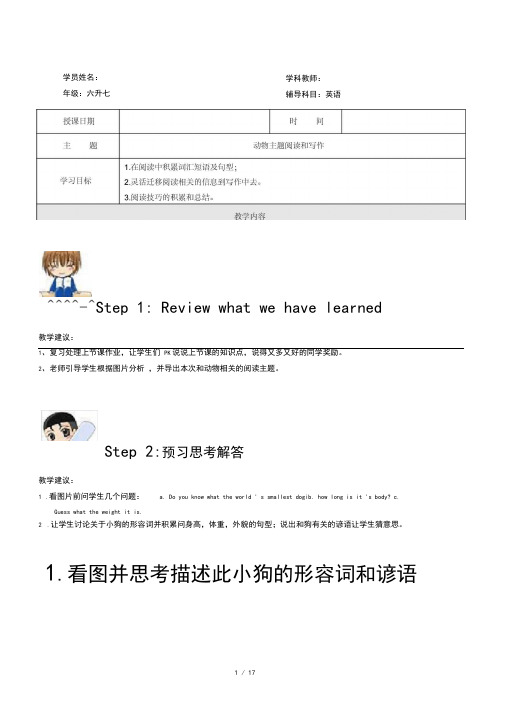
学员姓名: 年级:六升七^^^^-^Step 1: Review what we have learned教学建议:1、复习处理上节课作业,让学生们 PK 说说上节课的知识点,说得又多又好的同学奖励。
2、老师引导学生根据图片分析 ,并导出本次和动物相关的阅读主题。
Step 2:预习思考解答教学建议:1 .看图片前问学生几个问题:a. Do you know what the world ' s smallest dogib. how long is it 's body?c.Guess what the weight it is.2 .让学生讨论关于小狗的形容词并积累问身高,体重,外貌的句型;说出和狗有关的谚语让学生猜意思。
1.看图并思考描述此小狗的形容词和谚语学科教师: 辅导科目:英语(至少各写出三个)。
Keys: Phrases and sentences about animals1.lovely, cute, faithful, be friendly to, be loyal to …2.What ' the weight of …what ' the height of …what ' the length of a dog? What does ….look like?3.和狗有关的谚语:love me, love my dog 爱屋及乌He is a lucky dog.他是一个幸运儿。
Barking dogs seldom bite. 爱叫的狗不咬人;咬人的狗不露齿.2.Guessing games !1.Why are giraffes the cheapest to feed ?为什么养长颈鹿最不花钱?2.Why are dogs afraid to sunbathe?狗为什么害怕日光浴?3.Why is the pig always eating?猪为什么没完没了地吃?3 Why doi birds fly south?鸟为什么往南飞?Keys:1.They make a little food go a long wag因为它们脖子长,一点点食物都要走很长的路才能咽下去。
英语(仁爱版)六升七暑假精品课程 第07讲 Unit 3 Topic 2
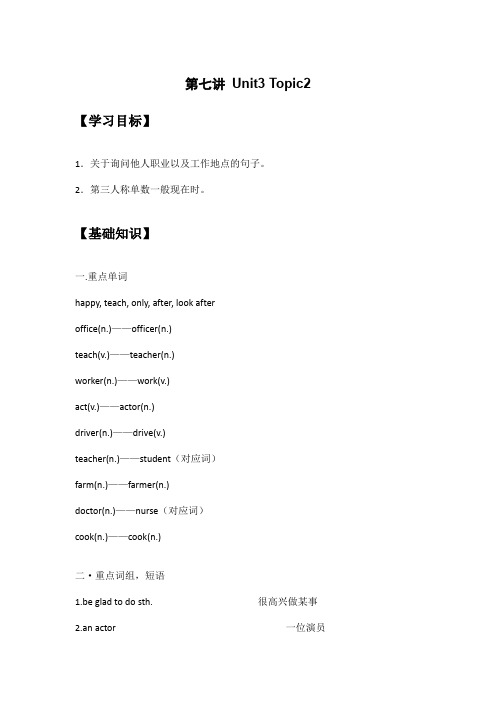
第七讲Unit3 Topic2【学习目标】1.关于询问他人职业以及工作地点的句子。
2.第三人称单数一般现在时。
【基础知识】一.重点单词happy, teach, only, after, look afteroffice(n.)——officer(n.)teach(v.)——teacher(n.)worker(n.)——work(v.)act(v.)——actor(n.)driver(n.)——drive(v.)teacher(n.)——student(对应词)farm(n.)——farmer(n.)doctor(n.)——nurse(对应词)cook(n.)——cook(n.)二·重点词组,短语1.be glad to do sth. 很高兴做某事2.an actor 一位演员3.an office worker 办公室职员,白领4. show sb. sth. = show sth. to sb. 把某物给某人看5. the young woman in yellow 穿黄衣服的年轻女士6. a photo of my family 我家的全家照7. on the sofa 在长沙发上8. family tree 家谱9. live in sp. 住在某地10. live with sb. 与某人住在一起11. like doing sth. / like to do sth. 喜欢做…...12. play with sth./sb. 和….玩三.重点句型1. What do your parents do? They are office workers.你的父母是做什么工作的?他们是办公室职员。
What do / does…do ? (提问职业)这一特殊疑问句是用来询问对方职业或身份的常用句型。
回答方式:人称代词主格+be(is / am / are ) +职业。
拓展:询问职业和身份还可以用下面的结构:⑴what + be 的适当形式+ 主语?例:—What is your mother? 你妈妈是干什么的?—She is a teacher. 她是老师。
小升初暑期英语六升七新七年级新初一讲义第3讲 介词和介词短语(含练习答案)
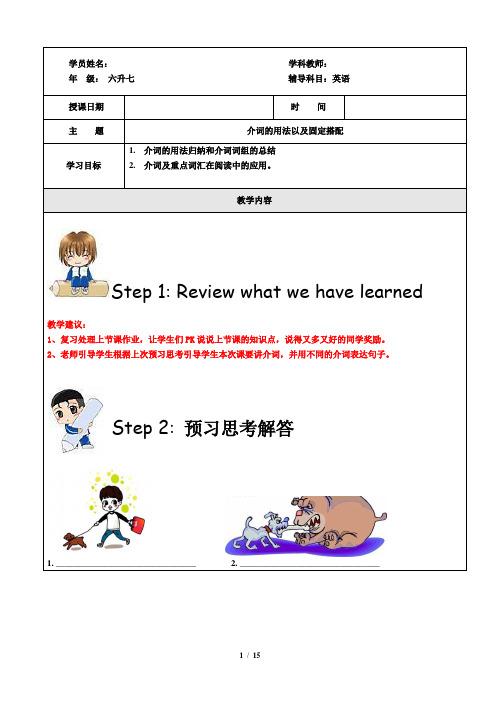
学员姓名:学科教师:年级:六升七辅导科目:英语授课日期时间主题介词的用法以及固定搭配学习目标1.介词的用法归纳和介词词组的总结2.介词及重点词汇在阅读中的应用。
教学内容Step 1: Review what we have learned教学建议:1、复习处理上节课作业,让学生们PK说说上节课的知识点,说得又多又好的同学奖励。
2、老师引导学生根据上次预习思考引导学生本次课要讲介词,并用不同的介词表达句子。
Step 2: 预习思考解答1. ________________________________2. ________________________________3.________________________________4. ________________________________5. ________________________________6. ________________________________Keys:1.The dog is walking in front of the boy.2.There is a bone between the two dogs.3.There is a bone above the dog.4.The dog is digging a hole to bury the bone under the ground.5.The balloon is next to the dog.6.The dog is sleeping on the house.知识名称介词【知识梳理1】地点介词介词是一种虚词,不能独立使用。
介词之后一般有名词或代词(宾格..)或相当于名词的其他词类、短语或从句作它的宾语,即构成介词短语。
有些介词是由两个以上的词构成的短语介词,如:out of(从…中出来), because of(因为), away from(距离…), on top of(在…顶上), ever since(自从…), next to(在…隔壁), according to(根据…), in front of(在…前方)等。
上海暑期英语小升初六升七新初一讲义牛津版6BU1-U3复习现在完成时(一)
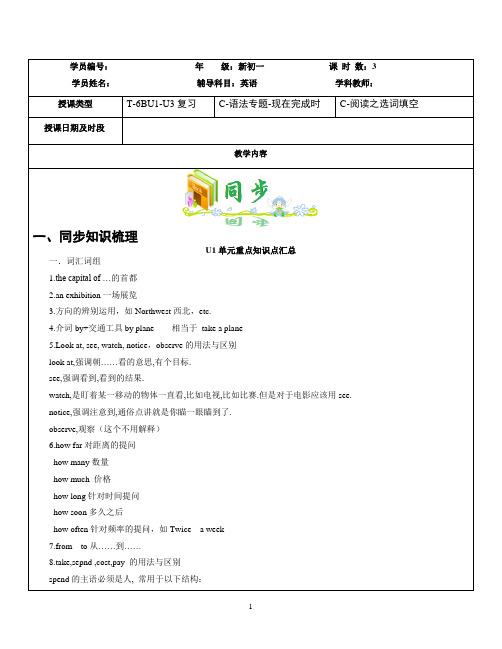
学员编号:年级:新初一课时数:3学员姓名:辅导科目:英语学科教师:授课类型T-6BU1-U3复习C-语法专题-现在完成时C-阅读之选词填空授课日期及时段教学内容一、同步知识梳理U1单元重点知识点汇总一.词汇词组1.the capital of …的首都2.an exhibition一场展览3.方向的辨别运用,如Northwest西北,etc.4.介词by+交通工具by plane 相当于take a plane5.Look at, see, watch, notice,observe的用法与区别look at,强调朝……看的意思,有个目标.see,强调看到,看到的结果.watch,是盯着某一移动的物体一直看,比如电视,比如比赛.但是对于电影应该用see.notice,强调注意到,通俗点讲就是你瞄一眼瞄到了.observe,观察(这个不用解释)6.how far对距离的提问how many数量how much 价格how long针对时间提问how soon多久之后how often针对频率的提问,如Twice a week7.from to从……到……8.take,sepnd ,cost,pay 的用法与区别spend的主语必须是人, 常用于以下结构:1357911A. fixingB. fixC. fixedD. fixes一、专题知识梳理一、现在完成时的构成1. 肯定式:主语+have/has +过去分词+其它① I've just copied some new words. 我刚抄写了所有的生词。
(表示不要再抄了)② She has lost her books. 她丢失了她的书。
(表示到目前为止还没有找到)③ We've just cleaned the classroom. 我们刚好打扫了教室。
(表明现在教室是干净的)2. 否定式:主语+have/has+not+过去分词+其它① I haven't finished my homework yet.② She hasn't travelled on a train.③ We have never spoken to a foreigner.④ I have never seen him before.3. 一般疑问式:Have/Has+主语+过去分词+其它?①—Have you ever made dumplings? —Yes, I have.②—Has she ever been abroad? —No, never.③—Have they found the lost books yet? —Yes, they have.二、现在完成时的用法1. 现在完成时的用法一:表示过去发生或已经完成的某一动作对现在造成的影响或结果。
上海暑期英语小升初六升七新初一讲义听力阅读CD篇作文(牛津新世纪版本通用)(七)
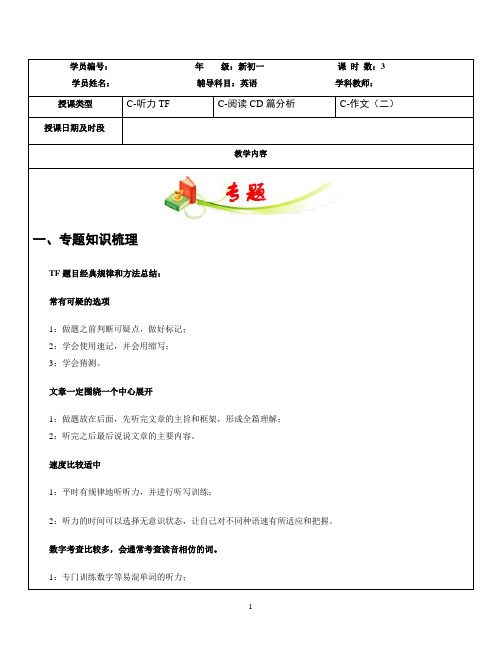
学员编号:年级:新初一课时数:3学员姓名:辅导科目:英语学科教师:授课类型C-听力TF C-阅读CD篇分析C-作文(二)授课日期及时段教学内容一、专题知识梳理TF题目经典规律和方法总结:常有可疑的选项1:做题之前判断可疑点,做好标记;2:学会使用速记,并会用缩写;3:学会猜测。
文章一定围绕一个中心展开1:做题放在后面,先听完文章的主旨和框架,形成全篇理解;2:听完之后最后说说文章的主要内容。
速度比较适中1:平时有规律地听听力,并进行听写训练;2:听力的时间可以选择无意识状态,让自己对不同种语速有所适应和把握。
数字考查比较多,会通常考查读音相仿的词。
1:专门训练数字等易混单词的听力;12:平时可以跟读磁带,适当纠正自己的发音。
原文和选项经常表达的意思是完全一样的,只是用了不同表达方式。
1:注意原文和选项的差别,仅仅小词的差别也会影响最终的判断;2:平时同义词组的积累;3:用心发现,并在口语中、写作中、阅读中进行发现和运用。
二、专题精讲U1答案:FFTFTT三、专题过关U2答案:TFFTFF四、学法提炼1.听力判断题目,主要是先要预判断,找出可疑点,比如:数字、绝对的词only、every、all、never等。
2.听力判断题目,练习的是学生的基本功,平时可以制订听力计划,每天进行听力训练。
一、专题知识梳理(1)C篇阅读,即首字母阅读,考查的是学生的语言综合能力,包括:基础知识的掌握运用、词组搭配的使用能力、辨析词义的能力和逻辑推断能力。
平时,要从词性、词义、词汇、词形四方面进行训练。
3(2)D篇阅读,即回答问题,考查的是学生的审题能力、寻找信息的能力和整合信息的能力。
特别要注意的是两方主观题的解题思路及技巧主旨题答题原则:对于开放性问题的回答,应根据原文大意、中心思想和作者的情感、立场展开合理的想象。
思路及技巧:1)句式结构:I think he/she …/We need to be …/I can learn …from him/her2)具体内容:需要从文章出发,了解全文主旨大意,判断作者的意图,或者全文能够反映出的主旨思想,我们从中得到的启发,再结合现实状态给出自己的观点或想法。
六升七暑假英语学习计划
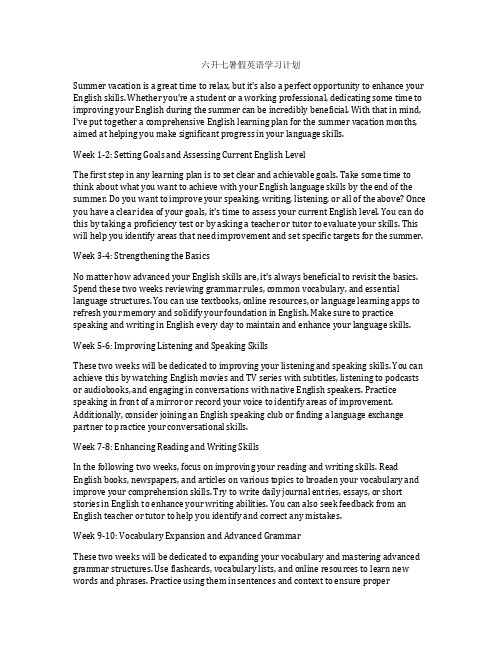
六升七暑假英语学习计划Summer vacation is a great time to relax, but it's also a perfect opportunity to enhance your English skills. Whether you're a student or a working professional, dedicating some time to improving your English during the summer can be incredibly beneficial. With that in mind, I've put together a comprehensive English learning plan for the summer vacation months, aimed at helping you make significant progress in your language skills.Week 1-2: Setting Goals and Assessing Current English LevelThe first step in any learning plan is to set clear and achievable goals. Take some time to think about what you want to achieve with your English language skills by the end of the summer. Do you want to improve your speaking, writing, listening, or all of the above? Once you have a clear idea of your goals, it's time to assess your current English level. You can do this by taking a proficiency test or by asking a teacher or tutor to evaluate your skills. This will help you identify areas that need improvement and set specific targets for the summer.Week 3-4: Strengthening the BasicsNo matter how advanced your English skills are, it's always beneficial to revisit the basics. Spend these two weeks reviewing grammar rules, common vocabulary, and essential language structures. You can use textbooks, online resources, or language learning apps to refresh your memory and solidify your foundation in English. Make sure to practice speaking and writing in English every day to maintain and enhance your language skills. Week 5-6: Improving Listening and Speaking SkillsThese two weeks will be dedicated to improving your listening and speaking skills. You can achieve this by watching English movies and TV series with subtitles, listening to podcasts or audiobooks, and engaging in conversations with native English speakers. Practice speaking in front of a mirror or record your voice to identify areas of improvement. Additionally, consider joining an English speaking club or finding a language exchange partner to practice your conversational skills.Week 7-8: Enhancing Reading and Writing SkillsIn the following two weeks, focus on improving your reading and writing skills. Read English books, newspapers, and articles on various topics to broaden your vocabulary and improve your comprehension skills. Try to write daily journal entries, essays, or short stories in English to enhance your writing abilities. You can also seek feedback from an English teacher or tutor to help you identify and correct any mistakes.Week 9-10: Vocabulary Expansion and Advanced GrammarThese two weeks will be dedicated to expanding your vocabulary and mastering advanced grammar structures. Use flashcards, vocabulary lists, and online resources to learn new words and phrases. Practice using them in sentences and context to ensure properunderstanding and retention. Additionally, study advanced grammar topics such as complex sentence structures, tenses, and conditionals to further enhance your language skills. Week 11-12: Test Preparation and ReviewAs the summer vacation comes to an end, use the last two weeks to prepare for a proficiency test or an English language exam. Review all the topics and language skillsyou've worked on throughout the summer and take practice tests to assess your readiness. Identify any weak areas and focus on improving them before taking the actual exam.In addition to the outlined plan, make sure to immerse yourself in the English language as much as possible throughout the summer. This can include watching English news, participating in online forums or discussions, and consuming English media. Remember that consistent practice and dedication are key to making significant progress in your English language skills. Good luck with your summer English learning journey!。
6升7假期英语学习计划
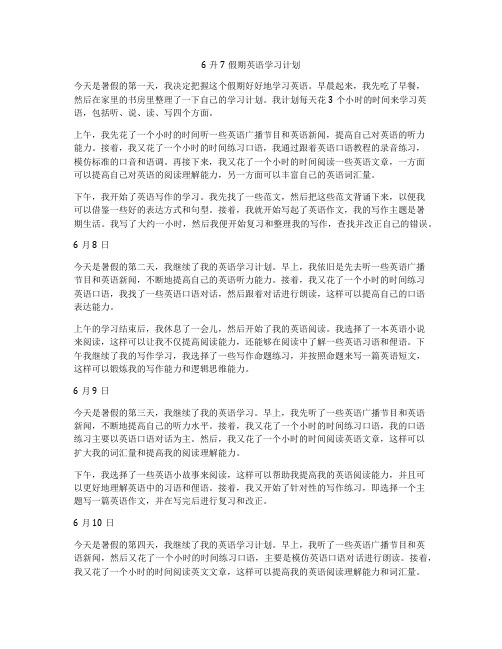
6升7假期英语学习计划今天是暑假的第一天,我决定把握这个假期好好地学习英语。
早晨起来,我先吃了早餐,然后在家里的书房里整理了一下自己的学习计划。
我计划每天花3个小时的时间来学习英语,包括听、说、读、写四个方面。
上午,我先花了一个小时的时间听一些英语广播节目和英语新闻,提高自己对英语的听力能力。
接着,我又花了一个小时的时间练习口语,我通过跟着英语口语教程的录音练习,模仿标准的口音和语调。
再接下来,我又花了一个小时的时间阅读一些英语文章,一方面可以提高自己对英语的阅读理解能力,另一方面可以丰富自己的英语词汇量。
下午,我开始了英语写作的学习。
我先找了一些范文,然后把这些范文背诵下来,以便我可以借鉴一些好的表达方式和句型。
接着,我就开始写起了英语作文,我的写作主题是暑期生活。
我写了大约一小时,然后我便开始复习和整理我的写作,查找并改正自己的错误。
6月8日今天是暑假的第二天,我继续了我的英语学习计划。
早上,我依旧是先去听一些英语广播节目和英语新闻,不断地提高自己的英语听力能力。
接着,我又花了一个小时的时间练习英语口语,我找了一些英语口语对话,然后跟着对话进行朗读,这样可以提高自己的口语表达能力。
上午的学习结束后,我休息了一会儿,然后开始了我的英语阅读。
我选择了一本英语小说来阅读,这样可以让我不仅提高阅读能力,还能够在阅读中了解一些英语习语和俚语。
下午我继续了我的写作学习,我选择了一些写作命题练习,并按照命题来写一篇英语短文,这样可以锻炼我的写作能力和逻辑思维能力。
6月9日今天是暑假的第三天,我继续了我的英语学习。
早上,我先听了一些英语广播节目和英语新闻,不断地提高自己的听力水平。
接着,我又花了一个小时的时间练习口语,我的口语练习主要以英语口语对话为主。
然后,我又花了一个小时的时间阅读英语文章,这样可以扩大我的词汇量和提高我的阅读理解能力。
下午,我选择了一些英语小故事来阅读,这样可以帮助我提高我的英语阅读能力,并且可以更好地理解英语中的习语和俚语。
小升初暑期英语六升七新七年级新初一讲义第5讲 代词(含练习答案)
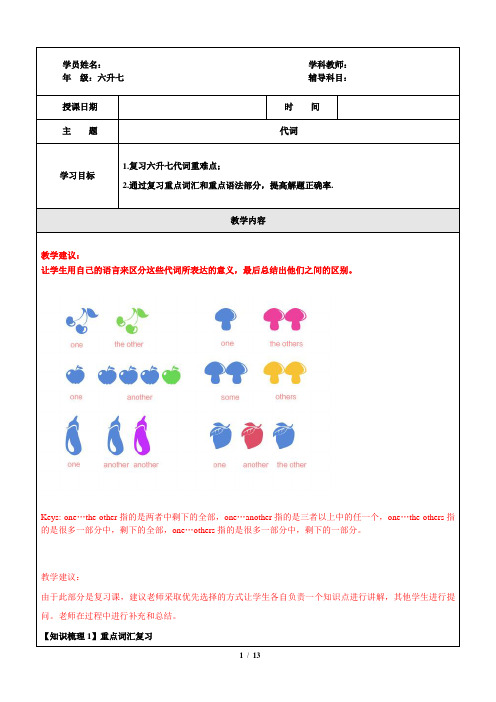
教学建议:让学生用自己的语言来区分这些代词所表达的意义,最后总结出他们之间的区别。
Keys: one…the other指的是两者中剩下的全部,one…another指的是三者以上中的任一个,one…the others指的是很多一部分中,剩下的全部,one…others指的是很多一部分中,剩下的一部分。
教学建议:由于此部分是复习课,建议老师采取优先选择的方式让学生各自负责一个知识点进行讲解,其他学生进行提问。
老师在过程中进行补充和总结。
【知识梳理1】重点词汇复习weigh v.称重量,测出重量practice v.实践;练习agree v.同意instead adv.代替departure n.离开;出发transportation n. 交通;运输die v.(die-died-died现在分词dying)死sink v.(使)下沉rather adv.宁愿,宁可;更确切地;有点,相当fiercely adv.强烈地;猛烈地remember v.想起,记起intelligent adj.聪明的;有智慧的turn…o ff 把……关上(龙头,电器等)competition n.竞争;竞赛,比赛dripping adj.滴水的,湿淋淋的【例题精讲】例1.Please turn_______the light before you leave.例2.I would ______stay at home than go outside.Keys:off rather【巩固练习】1.We have different opinion, so I ______with you.2.My grandpa has been ______for three years.Keys:disagree dead【知识梳理2】人称代词人称代词即表示“你、我、他、你们、我们、他们”等的词,它的人称、数和格的变化见下表人称代词排序口诀S人称代词并列观,注意顺序礼貌见;单数人称二、三、一,复数人称一、二、三;麻烦事情“我”站前,其他人称没意见;两性并用为三单,男先女后是习惯。
英语(仁爱版)六升七暑假精品课程 Unit1、2
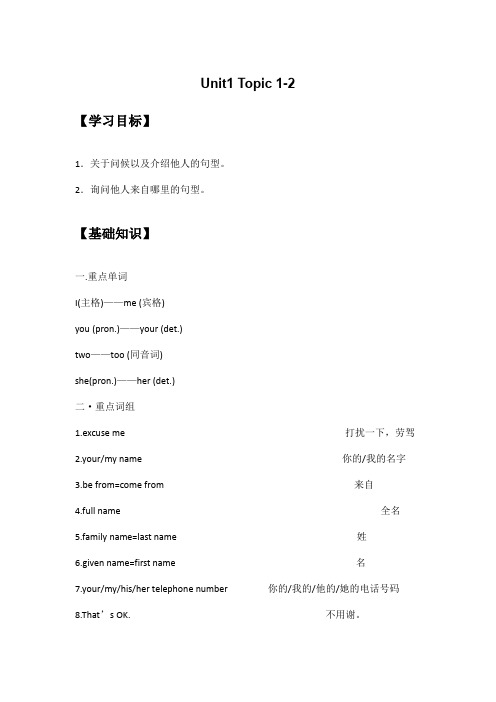
Unit1 Topic 1-2【学习目标】1.关于问候以及介绍他人的句型。
2.询问他人来自哪里的句型。
【基础知识】一.重点单词I(主格)——me (宾格)you (pron.)——your (det.)two——too (同音词)she(pron.)——her (det.)二·重点词组1.excuse me 打扰一下,劳驾2.your/my name 你的/我的名字3.be from=come from 来自4.full name 全名5.family name=last name 姓6.given name=first name 名7.your/my/his/her telephone number 你的/我的/他的/她的电话号码8.That’s OK. 不用谢。
9.This is ... (介绍)这是……三.重点句型1. Good morning / afternoon 早上/下午好西方人一般早上或上午见面时,说Good morning ; 下午见面说Good afternoon;晚上见面说Good evening; 晚安说Good night2. Hello! 你好Hello! 是最广泛,最简单的打招呼用语,显得亲切自然,答语用Hello或Hi。
3. Nice to meet you. 见到你很高兴这是一种问候语,两人初次见面时用,表示很高兴认识对方. 其答语为Nice to meet you, too. 见到你我也很高兴. 熟识后则用Nice to you.4. Welcome to China.Welcome to+地名或场所表示欢迎…….到, 欢迎光临……Welcome 表示一种亲切的称呼,可单独使用,也可与to 连用.如:Welcome ! 欢迎光临Welcome my school.欢临光临我校.5. How do you do? 您好!初次见面,经介绍后问候常说How do you do? 回答也答也用How do you do?两人通常相互握手,特别是对长辈用此句子,以示庄重,礼貌. 这个句子虽然后面用问号,但实际并不是问句。
小升初暑期英语六升七新七年级新初一讲义第9讲 形容词副词比较级(含练习答案)
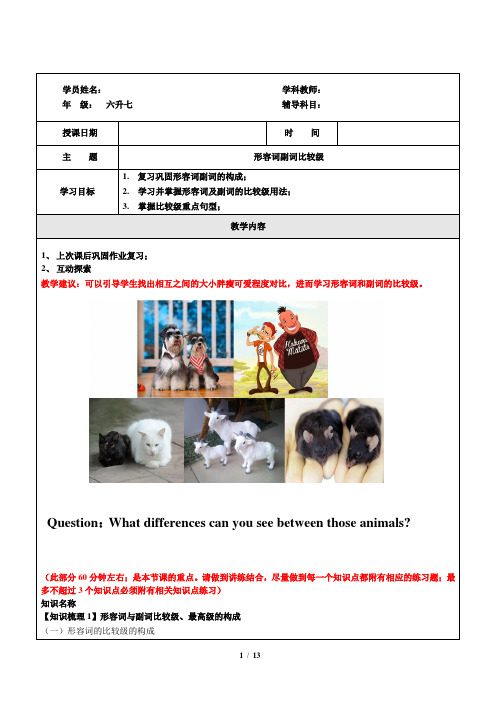
学员姓名: 学科教师: 年 级: 六升七 辅导科目: 授课日期时 间主 题形容词副词比较级学习目标1. 复习巩固形容词副词的构成;2. 学习并掌握形容词及副词的比较级用法;3. 掌握比较级重点句型;教学内容1、 上次课后巩固作业复习;2、 互动探索教学建议:可以引导学生找出相互之间的大小胖瘦可爱程度对比,进而学习形容词和副词的比较级。
(此部分60分钟左右;是本节课的重点。
请做到讲练结合,尽量做到每一个知识点都附有相应的练习题;最多不超过3个知识点必须附有相关知识点练习) 知识名称【知识梳理1】形容词与副词比较级、最高级的构成 (一)形容词的比较级的构成Question :What differences can you see between those animals?情况 构成方式 原级 比较级 一般情况加-er 或-estnewlongnewer longer 以-e 结尾 加-r 或-st fine latefiner later 以“辅音字母+y ” 结尾的词 变y 为i 再加-er 或-est early happyearlier happier 以重读闭音节结尾的词先双写辅音字母,再加-er 或-esthot thin fat hotter thinner fatter 多音节词和部分双音节词在其前面加more/most useful difficult deliciousmore useful more difficult more delicious.【重难点】搞清两种比较级的区别 原级 类别 比较级 区别 ①far 第一类 farther 强调距离 第二类 further 强调程度 ②old 第一类 elder 强调长幼顺序第二类 older 强调年龄大小 【例题精讲】例题1: --- Which coat is ____on me, the blue one or the black one?--- The blue one. A. good B. better C. best D. the best[答案] B 。
专题03句型六升七小升初英语暑假专项提升(人教pep版)

4. Carl went fishing yesterday. (对画线部分提问) _W__h_a_t_d_i_d_C_a_r_l_d_o__ye_s_t_e_rd_a_y_?____________________
5. rode, with, bike, I, a, my, Sunday, last, father (. )(连词 成句) __I _ro_d_e__a_b_i_k_e_w_i_t_h_m__y_f_a_th_e_r_l_a_st__S_u_n_d_ay_.__________
I cleaned my room.
How waerree you ytoedstaeyr?day?
I am fine.
I was fine.
句型学习
Did he read a book yesterday? Yes,he did.
句型学习
Did she _____ yesterday? Yes, she did./ No, she didn't.
You were ...
候
You had...
照
You liked...
片
You could...
was no gym
last year
were no taxis
is a new dining hall
was
five years ago
二、按要求做题: 1. Did you go cycling last Sunday?(做否定回答)
How long is your arm?
—It's ... yuan.
—It is ...cm.
你身体好吗?
—How are you? —I'm fine.
小升初暑期英语六升七新七年级新初一讲义第1讲 冠词(含练习答案)
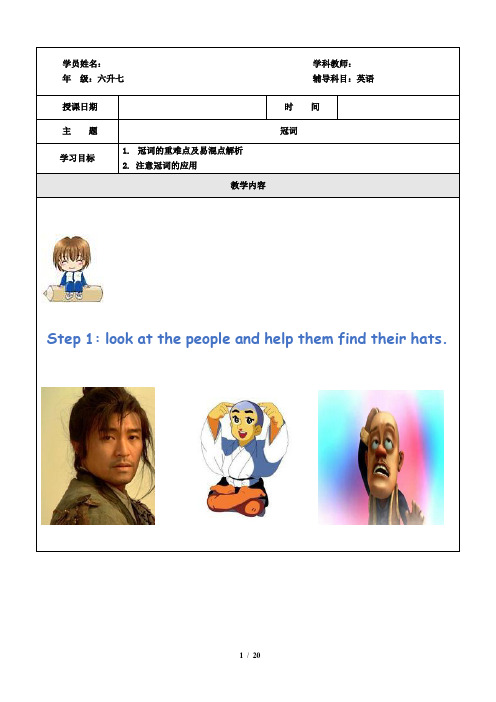
Step 1: look at the people and help them find their hats.Step 2: 找不同Step3:欣赏美文Companionship of Books 以书为伴(节选)A good book may be among the best of friends. It is the same today that it always was,【知识梳理2】定冠词I.基本概念:定冠词具有确定的意思,用以特指人或事物,表示名词所指的人或事物是同类中的特定的一个,以别于同类中其他的人或事物,相当于汉语中的“那个”或“这个”的意思。
它可以和单、复数名词,也可以和不可数的名词连用。
而零冠词是指不用冠词的情况。
II.定冠词用法:A:常规用法:1. 用以特指某(些)人或某(些)事物This is the house where Luxun once lived.这是鲁迅曾经住过的房子。
2.用于指谈话双方都明确所指的人或事物Open the door,please.请把门打开。
3.用以复述上文提过的人或事物(第一次提到用“a或an”,以后再次提到用“the”)Once there lived a lion in the forest. Every day the lion asked small animals to look for food for him.从前森林里住着一只狮子。
每天这只狮子要小动物们为他寻找食物。
B:定冠词口诀:在早晨,富人史密斯一家,做的第一件,也是最重要的一件事,就是站在长城上,对着东方的太阳和大海弹吉他。
定冠词的口诀用法详解:1.某些固定的表达法in the morning 在早上in the afternoon 在下午in the evening 在晚上go to the cinema 去看电影all the year round 一年到头on the way to 前往...去的路上2.和某些形容词连用,使形容词名词化,代表一类人或物the poor 穷人the rich 富人the sick 病人the wounded 伤员the good 好人the beautiful 美丽的事物3.在姓氏复数前,表示一家人The Bakers came to see me yesterday.贝克一家人昨天来看我。
上海暑期英语小升初六升七新初一讲义牛津版6BU7-U10复习句子改写(三)
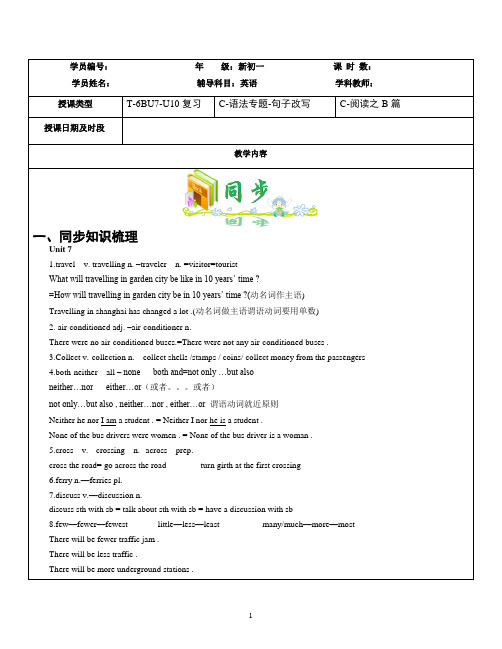
学员编号:年级:新初一课时数:学员姓名:辅导科目:英语学科教师:授课类型T-6BU7-U10复习C-语法专题-句子改写C-阅读之B篇授课日期及时段教学内容一、同步知识梳理Unit 71.travel v. travelling n. –traveler n. =visitor=touristWhat will travelling in garden city be like in 10 years’ time ?=How will travelling in garden city be in 10 years’ time ?(动名词作主语)Travelling in shanghai has changed a lot .(动名词做主语谓语动词要用单数)2. air-conditioned adj. –air-conditioner n.There were no air-conditioned buses.=There were not any air-conditioned buses .3.Collect v.-collection n. collect shells /stamps / coins/ collect money from the passengers4.both-neither all –none both and=not only …but alsoneither…nor either…or(或者。
或者)not only…but also , neither…nor , either…or 谓语动词就近原则Neither he nor I am a student . = Neither I nor he is a student .None of the bus drivers were women . = None of the bus driver is a woman .5.cross v.-- crossing n.--across prep.cross the road= go across the road turn girth at the first crossing6.ferry n.—ferries pl.7.discuss v.—discussion n.discuss sth with sb = talk about sth with sb = have a discussion with sb8.few—fewer—fewest little—less—least many/much—more—mostThere will be fewer traffic jam .There will be less traffic .There will be more underground stations .135_____________ is your teacher ______________?答案:What like原因:觉得..怎么样,用what...like? 或者是how is.....?知识拓展:What is the weather like? = How is the weather? 天气如何What do you think of ...? = How do you like ...? 你觉得...如何?How does your mother look? = What does your mother look like?你妈妈长得怎么样?三、课堂达标检测检测1:1. We usually take ____________________ air-conditioned bus in summer and winter.A. aB. anC. theD. /2. Both my mother and my aunt are _____________________ .A. woman driverB. woman driversC. women driverD. women drivers3. In the past, ___________________ the bus drivers are women.A. some ofB. many ofC. none ofD. most of4. ________will travelling in Garden City______in the future?A. What. . . likeB. What. . . be likeC. How. . . likeD. How. . . be like5. Perhaps there __________________ more underground station in the future.A. will haveB. will hasC. will beD. will is6. Our school ___________________ a garden.A. is likeB. likesC. is likedD. will like8. I will be a teacher _____________________ time.A. in ten year'sB. in ten years'C. after ten yearsD. after ten years'9. There were ___________________ traffic jams in the past.A. moreB. muchC. fewerD. less11. We are going to visit Garden City_____________.A. next SundayB. last SundayC. the next SundayD. the last Sunday14. Where______your sister _____ on Green Island?A. have. ..beenB. has. ..beenC. is. . . beenD. goes15. What about_______to Ocean Park?A. goingB. to goC. goD. went16. All of the bus drivers are men. (保持句意不变)____________ ____________of the bus drivers are ______________.1. B2. D3. C4. B5. C6. A 8. B 9. C 11. A 14. B 15. A 16. None. ..women 检测2:1. Sometimes_________typhoon is dangerous.A. aB. anC. theD. /2. Mother is taking______into the flat.A. flower potB. flowers potC. flower potsD. flowers pots3. We may_______home when it is raining heavily.A. stayB. stay atC. stayingD. staying at4. I can see people_________when there is a strong wind.A. windsurfingB. to windsurfC. windsurfedD. windsurffing6. Ben holds his hat____________in the street when the wind blows_______.A. gently. . . lightlyB. quickly. . . suddenlyC. tightly. . . fiercelyD. immediately. . . slightly7. The story happened_________a rainy night _ last summer.A. in. . . inB. on. . . /C. at. . . inD. on. . . in9. There's______traffic in the city. We all hope there will be______ traffic jams in the future.A. many. . . fewB. much. . . lessC. a lot of. . . fewerD. less. . . more10. Tommy feels__________because he has got poor marks in the exam.A. happilyB. unhappyC. happyD. unhappily11. Linda often helps her mother_________the housework on weekends.A. withB. toC. ofD. for12. There_______a new film on next week.A. will haveB. hasC. will beD. will is13. I can't find my keys. It here just now. Who_____________it away?A. was. . . has takenB. was. . . tookC. has been. . . has takenD. has been. . . took14. _______November 2005, Mr White flew to London for a meeting.A. AtB. InC. OnD. During71. A2. C3. B4. A 6. C 7. B 9. C 10. B 11. A 12. C 13. A 14. B一、专题知识梳理句子改写包括一般疑问句、特殊疑问句、反义疑问句、否定句、感叹句、同义句、连词成句,考查的是学生对句式的掌握,特别需要强调的还是基本功:时态、单复数、基本词组搭配等。
上海暑期英语小升初六升七新初一讲义6B易错题(二)阅读作文(牛津新世纪版本通用)(十)
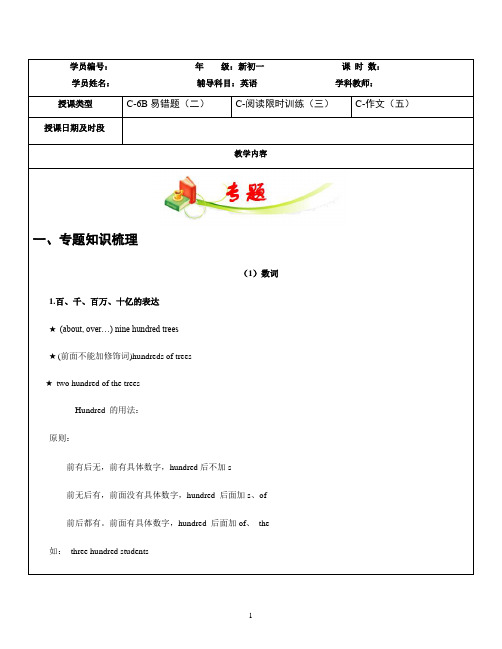
学员编号:年级:新初一课时数:学员姓名:辅导科目:英语学科教师:授课类型C-6B易错题(二)C-阅读限时训练(三)C-作文(五)授课日期及时段教学内容一、专题知识梳理(1)数词1.百、千、百万、十亿的表达★ (about, over…) nine hundred trees★(前面不能加修饰词)hundreds of trees★ two hundred of the treesHundred 的用法:原则:前有后无,前有具体数字,hundred后不加s前无后有,前面没有具体数字,hundred 后面加s、of前后都有。
前面有具体数字,hundred 后面加of、the如:three hundred students135healthy healthier healthiestfunny funnier funniestold older(表语)oldest(表语)elder(定语,“年长的”)eldest(定语,“最年长的”)far farther(距离上,“更远的”)farthest(距离上,“最远的”)further(程度上,“进一步的”)furthest(程度上,“最大程度的”)注意:big、red、hot、thin等需要双写。
形容词变反义词规则加前缀un- usual →unusual,able →unable,healthy →unhealthy dis- honest→ dishonestim-/in- possible →impossible,dependent →independent加后缀-less careful →careless,useful →useless(3)时态(1)一般现在时:表示现在经常性,或习惯性的动作。
或表示客观真理。
主要通过时间状语进行判断。
例如:always,every year等。
另一方面,一般现在时也会出现在条件状语从句和时间状语从句中。
例如:When he comes here, he will tell you the truth.(2)一般过去时:表示在过去的某一时间发生的动作或存在的状态。
上海暑期英语小升初六升七新初一讲义牛津版7AU2重点词汇一般现在时一般过去时(十二)
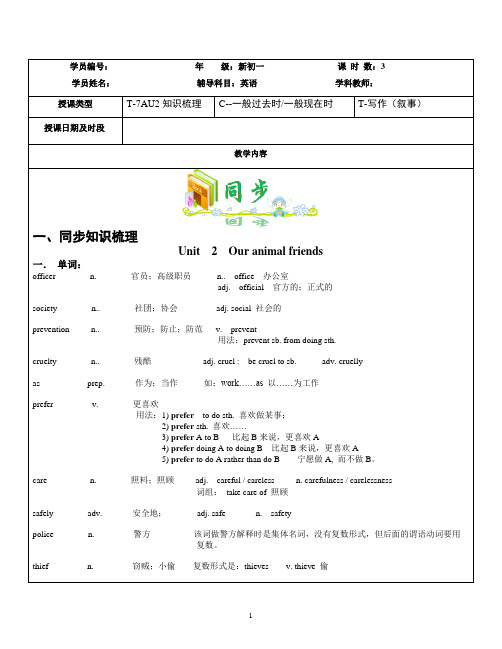
学员编号:年级:新初一课时数:3学员姓名:辅导科目:英语学科教师:授课类型T-7AU2知识梳理C--一般过去时/一般现在时T-写作(叙事)授课日期及时段教学内容一、同步知识梳理Unit 2 Our animal friends一.单词:officer n. 官员;高级职员n.. office 办公室adj. official 官方的;正式的society n.. 社团;协会adj. social 社会的prevention n.. 预防;防止;防范v. prevent用法:prevent sb. from doing sth.cruelty n.. 残酷adj. cruel : be cruel to sb. adv. cruellyas prep. 作为;当作如:work……as 以……为工作prefer v. 更喜欢用法:1) prefer to do sth. 喜欢做某事;2) prefer sth. 喜欢……3) prefer A to B 比起B来说,更喜欢A4) prefer doing A to doing B 比起B来说,更喜欢A5) prefer to do A rather than do B 宁愿做A, 而不做B。
care n. 照料;照顾adj. careful / careless n. carefulness / carelessness词组:take care of 照顾safely adv. 安全地;adj. safe n. safetypolice n. 警方该词做警方解释时是集体名词,没有复数形式,但后面的谓语动词要用复数。
thief n. 窃贼;小偷复数形式是:thieves v. thieve 偷13一、专题知识梳理1. 一般过去时功能:1.一般过去时表示过去某个时间发生的动作或存在的状态,常和表示过去的时间状语连用。
2.一般过去时也表示过去经常或反复发生的动作感谢。
- 1、下载文档前请自行甄别文档内容的完整性,平台不提供额外的编辑、内容补充、找答案等附加服务。
- 2、"仅部分预览"的文档,不可在线预览部分如存在完整性等问题,可反馈申请退款(可完整预览的文档不适用该条件!)。
- 3、如文档侵犯您的权益,请联系客服反馈,我们会尽快为您处理(人工客服工作时间:9:00-18:30)。
初中英语预备教材《初中英语预备教材》是针对小学升初中的学生编制的.为使小学生更好的过渡到初中,为以后的中学英语学习打下坚实的基础,本教材采用任务形语言教学模式, 它囊括了《新目标》英语的重点句形、段落、篇章、语法点及常用的一些积极词汇。
能使学生提前并更全面的掌握初中英语最基本的语言点.本书每个单元都包括A, B和C三部分。
A部分是本课要求掌握的单词及词组,B部分是最基本的语言点和一些重点句型,C部分是单元综合评价, 学生可用来检测本单元所学的语言知识。
本书共40个课时,14个单元.我们相信,只要孩子们珍惜并认真使用本书,都能很好地掌握初一的英语知识,在新学期成绩遥遥领先,树立起强大的自信心!由于时间仓促,不足之处,敬请指正!我们会不断地努力!编者目录语音学习unit 1 前元音和爆破音Unit 2 中元音和摩擦音Unit3 后元音和摩擦音Unit 4 河口双元音和鼻音Unit5 集口双元音,半元音和舌侧音Unit6 破擦音Unit1. My name’s Gina.Unit2. This is my sister.Unit 3 Is this your pencil?Unit4. Where’s my schoolbag ? Unit5. Do you have a soccer ball?Review of units 1--5Unit6. Do you like bananas?Unit7. How much are these socks ? Unit8. When is your birthday?Unit9. My favorite subject is science. Unit 10 Can you play the guitar?Review of units 6--10Unit 1 前元音和爆破音1 Le’t watch前元音[ i: ] [ɪ] [ e] [æ]前元音发音特点: 舌尖抵下齿,舌前部挺起,口型扁平,不要收圆.但是各元音嘴巴张开的宽度不同爆破音[ p] [ t] [ k][ b] [ d] [ g]爆破音发音特点: 气流在通路上开始完全阻塞,随后气流有力急促地冲开阻碍而发出,但是[ p] [ t] [ k] 为清辅音,声带不振动,[ b] [ d][ g]为浊辅音,声带振动.Let’s read[pi:] [pɪ] [pe] [pæ][bi:] [bɪ] [be] [bæ][t i:] [tɪ] [te] [tæ][di:] [dɪ] [de] [dæ][ki:] [kɪ] [ke] [kæ][gi:] [gɪ] [ge] [gæ][pɪg] [pet] [pæd][bi:t] [bi:d] [bed] [bæd] [bet] [bæt][i:t] [ti:p] [tæp] [di:p] [dɪp] [det][dek] [dæd] [ki:p] [kɪk] [kæp] [keg] [get] [ gæp]Let’s do[pi:] ____[pɪg]___ [pet]____ [pæd]_____[pæt]____[bɪt]___ [bɪb]____ [bi:t]____[bed]___[bet]____[beg]____[bæd]____[bæg]____[bæt]_____[ti:]_____[i:t]_____ [dɪd]_____[di:p]____[ki:p___[kɪd]_____[kɪt]____ [kæp]____[kep]____[get]____例词bee [bi:] n. 蜜蜂pea [pi:] n. 豌豆bib [bɪb] n.围嘴围兜peep [pi:p]v. 窥视bed [bed] n.床bet [bet] v.打赌dad [dæd] n.爸爸pad [pæd]n. 便签本big [ bɪg] adj.大的cat [kæt] n. 猫egg [eg] n.鸡蛋gap [gæp]n. 分歧keg [keg] n. 小桶key [ki:] n. 钥匙Let’s learnSummary1 字p , b,t, d 是发音_______的辅音字母。
什么是不变,不变就不变,发音我不变,写法也不变。
2单词中两个相同的辅音字母在一起发相同的音时,只发一个音。
Let’s readback bad bag bit cap deep eat getit keep pig tea ticket at kid tipLet’s dokeep [ ] v保持pip [ ] n种子pet [ ] n宠物tap [ ] n水龙头bat [ ] n 球拍pap [ ] n无价值的读物pat [ ] v 轻拍pep [ ] v 使活跃tad [ ] n 少量tat [ ] n劣质货beak [ ]n 鸟beg [ ] n 恳求_____[pi:k ] n 顶峰_____ [pɪk ] v 选择_____ [di:p ] adj 深的____ [dɪp ] v浸_____ [kɪp ] n睡觉____ [kɪt ] n 配套元件_____[di:d ] n行为___ [dek ] n 甲板_____[æd ] v 增加_____[dɪd ] v. do 的过去式Unit 2 中元音和摩擦音中元音: [ɜ:] [ə] [ʌ]中元音发音特点:舌尖轻抵下齿,嘴的宽度是食指和中指叠加起来的宽度,,但舌身部位摆放不同.摩擦音: [s] [θ][ʃ][z] [ð] [ʒ]摩擦音发音特点:相同点:摩擦音发音时,两个发音器官接近,导致气流部分受到阻碍产生气流的摩擦运动。
不同点:[s] [θ][ʃ] 为清辅音,声带不震动,[z] [ð] [ʒ]为浊辅音,声带振动。
Let’s read.[sɜ:] [sə] [sʌ] [ zɜ:] [zə] [zʌ] [θɜ:] [θə] [θʌ][ðɜ:] [ðə] [ðʌ] [ʃɜ:] [ʃə] [ʃʌt] [ʒɜ:] [ʒə] [ʒʌ][s ʌk] [ʃi:t] [╹θɜ:ti] [ði:z] [θɜ:d][sʌs] [θɜ:sti] [sʌb] [ʃɜ:t] [ði]Let;s do[sɜ:] _______ [sʌb]______ [s ʌk] ______[╹θɜ:ti]______ [θʌd]____[ʃɜ:t]_______[ʃʌt] _______[θɜ:d] ______[ði:z_______[╹θɜ:sti]_____ [ði]_____ [sʌbɜ:b] ______例词先生sir [sɜ:] n.潜艇sub [sub]n.吮吸suck [sʌk] v.口渴的thirsty [θɜ:sti]adj.衬衫shirt [ʃɜ:t] n.公交车bus [bʌs] n.这个this [ðɪs] pron.姐妹sister [sɪstə] n.第三third [θɜ:] num.拉链zip [zɪp] n.郊区suburb [sʌbɜ:b] n.Let’s learnSummary1 字母组合th在单词中读_________ sh字母组合在单词中读________2 [s] 音后的浊化现象:符合“[s] + 清辅音+元音”结构,无论是在单词的最前面,还是中间,只要是在重读音节或是次重读音节里,一般都读成对应的浊辅音,如;stand, strick speak , sky 等等。
Let’s readteeth sub shirt burger bird thirstycup sit pup sheep that thisLet’s doteeth [] n牙齿third[] num 第三shirt [] n 衬衫burger[] n 汉堡包bird[] n 鸟thirty[] num 三十cup[] n 杯子sit[] v 坐sub[] n 潜艇sheep[]n 绵羊that[] pron 那个duck 鸭子nsupper[] n晚饭earth[] n 地球seat[] n 座位this[] pron 这个Review 1Let’s watchLet’s learn1. 数以万计的单词都是_____构成,它们有____个。
单词的发音都是由______构成,它们一共有____个。
2. A B CD E FG H I J K L M N OP Q R S TU V W X YZ请将发音有变化的五个元音字母写在下面_____________________________________________请将既能发辅音又能发元音的一个半元音字母写在下面请将发音不变化的15个辅音字母写在下面请将发音有变化的五个辅音字母写在下面______________________________3 [ : ] 为_____符号,带有此符号的读音较____,反之读音较_____.4 通常情况下,一个字母对应_____个音素,但很多时候,两个或多个字母也只对应_____个音素,5 单词中两个相同的辅音字母在一起发相同的音时,只发____个音。
6 一般来说,单词的音标中有多少个元音,就有多少个音节。
含有一个元音音素的单词称为____音节单词。
含有两个元音音素的单词称为____音节单词。
含有两个以上元音音素的单词称为____音节单词。
7 单音节词本身_____,省略重读符号;双音节单词和多音节单词中,会出现重音符号。
重音符号分为主重读“_____”(出现在____角)和次重读"______"(出现在_____角)。
含有重音符号部分要读得重而响亮,其他音节要读得相对较弱较低。
8 [s]音后的浊化现象:符合“___________”结构,无论是在单词最前面还是在中间,只要是在______音节或_______音节里,一般都读成对应_____辅音,如;stand, strick speak , sky 等等。
Let’s do敲打beat [] v小块bit [] n耍蛇的人geek [] n 小孩kid [] n深坑pit [] n 鱼fish [] n他的his []pron 遗憾pity [] n姐妹sister [] n三three num []第三third [] num 城市city [] n喂养feed [] v 厚的thick [] adj简易房______ [ʃed] n标签_______ [tæd ] n尖端________[tɪp ] n 旗帜_______[flæg] n找出画线部分读音不同的单词( ) 1 A bread B eat C tea D seat( ) 2 A never B leg C red D he( ) 3 A music B telescope C newspaper D maths ( ) 4 A this B that C these D thank( ) 5 A teacher B driver C term D waiter( ) 6 A behind B bedroom Cjacket D eleven( ) 7 A cry B circle C class D picture( ) 8 A thing B theatre C bathroom D there ( ) 9 A wash B sure C shape D square ( ) 10 A tea B meat C weather D beach( ) 11 A back B fast C have D map( ) 12 A second B mess C cinema D February ( ) 13 A season B beach C read D great( ) 13 A month B sixth C with D birthay( ) 14 A he B egg C dress D bedUnit 3 后元音和摩擦音Let’s watch后元音[ɑ:] [ɔ] [ɔ:] [u] [u:]后元音发音特点舌尖离开下齿,舌后部抬高,唇型自然略成圆形,但嘴巴收圆和双唇突出的程度不同,摩擦音[f][h][v][r]摩擦音发音特:相同点:摩擦音发音时,两个发音器官接近,导致气流部分受到阻碍产生气流的摩擦运动,不同点;[f][h]为清辅音,声带不振动, [v][r] 为浊辅音,声带振动Let’s read[fɑ:] [fɔ] [fɔ:] [f u] [f u:][vɑ:] [vɔ] [vɔ:] [v u] [v u:][hɑ:] [hɔ] [hɔ:] [h u] [h u:][rɑ:] [rɔ] [rɔ:] [r u] [r u:][kɑ:] [bɔks] [fɔ:ti] [ʃud] [pr u:d] [vɑ:z] [hɔp] [ɔ:θə] [k ud] [d u:] [ɑ:t] [hɔt] [dɔ:tə] [g u:s][fɑ:st] [hɔp] [kɔ:t] [t u:θ]Let’s do[fɑ:] [ɔf] [fɔ:k] [b uk] [t u:θ][hɑ:d] [kɔst] [bɔ:ks] [p ut] [t u:] [fɑ:k] [frɔg] [╹ti:pɔt] [h uk][bɑ:skit] [bɔks] [rɪ╹pɔ:t] [b uk]例词汽车 car n. [kɑ:]四十 forty num. [fɔ:ti]热的 hot adj. [hɔt]脚foot n. [f ut]推 push v. [p uʃ]背心 vest n. [vest]马 horse n. [hɔ:s]读 read v. [ri:d]Let’s learnSummary1 字母f v h r 是发音________的辅音字母。
